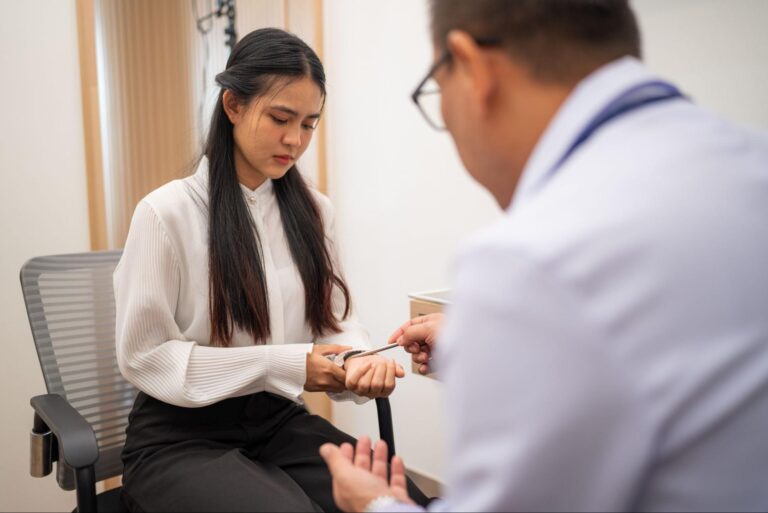Experiencing numbness in your fingertips can be unsettling, especially when it interferes with daily activities like typing, writing, or gripping objects. Although persistent numbness can raise concerns, many underlying causes are treatable with timely intervention. This guide provides an overview of 15 common causes of fingertip numbness and practical steps to help you address them.
By understanding these triggers and recognizing when professional help is needed, you can take proactive measures toward relief and improved hand function.
Understanding Fingertip Numbness
Fingertip numbness typically arises from issues related to nerves, circulation, or physical compression. While the symptom may be temporary and even mild, persistent numbness should be evaluated so that the underlying cause can be identified and addressed. Being aware of the possible reasons for numbness not only assists in self-monitoring but also prepares you to discuss your condition effectively with a healthcare provider.
Common Causes of Fingertip Numbness
Fingertip numbness can be attributed to a variety of factors. Below is an overview of 15 common causes:
Note: This is not an exhaustive list. This is not intended to be a diagnostic aid or medical advice. Please contact your healthcare professional if you believe any of this may apply to you.
1. Peripheral Neuropathy
Damage to peripheral nerves—commonly due to diabetes, infections, or injuries—may lead to numbness and tingling in the fingers. Managing blood sugar levels or treating the underlying condition is key. In many cases, this may involve what is known as peripheral neuropathy.
2. Carpal Tunnel Syndrome (CTS)
Carpal tunnel syndrome occurs when the median nerve is compressed at the wrist, causing numbness, tingling, and pain in the thumb, index, middle, and part of the ring finger. Repetitive hand motions can increase the risk, so early diagnosis is important.
3. Thoracic Outlet Syndrome
This condition stems from compression of nerves or blood vessels between the collarbone and first rib, which may reduce circulation to the arms and fingers. Adjusting physical activities and physical therapy can help relieve symptoms of thoracic outlet syndrome, especially when identified early.
4. Raynaud’s Disease
Raynaud’s causes extreme narrowing of blood vessels in response to cold or stress, leading to color changes and numbness in the fingertips. Simple measures, such as keeping warm and controlling stress triggers, may reduce episodes.
5. Vitamin Deficiencies
Deficiencies—especially of vitamin B12—can impair nerve function and result in numbness. A balanced diet or supplements can often correct these deficiencies and alleviate symptoms.
6. Cervical Radiculopathy
A pinched nerve in the neck, often due to herniated discs or bone spurs, can cause pain and numbness that radiates to the fingers. Conservative management with physical therapy is frequently effective. Learn more about cervical radiculopathy.
7. Repetitive Strain Injuries
Overuse of the wrists and hands during tasks such as typing or playing instruments can lead to repetitive strain injuries, which may irritate nerves and cause numbness. Regular breaks and ergonomic adjustments are beneficial.
8. Multiple Sclerosis (MS)
MS is an autoimmune disease that disrupts nerve signaling, sometimes resulting in numbness in the extremities. While numbness in isolation rarely signals MS, it should be evaluated when combined with other symptoms.
9. Stroke or Transient Ischemic Attack (TIA)
Sudden numbness, especially when accompanied by facial drooping or weakness on one side of the body, may signal a stroke—a medical emergency that requires immediate attention.
Seek medical attention immediately if you think you are experiencing these symptoms.
10. Alcohol-Related Nerve Damage
Chronic excessive alcohol consumption can cause alcoholic neuropathy, which manifests as numbness and tingling in the fingers. Reducing alcohol intake and improving nutrition can help prevent progression.
11. Medications
Certain medications, including some chemotherapy agents or antibiotics, may have side effects that include numbness. Discussing alternatives with your healthcare provider might reduce these unwanted effects.
12. Infections
Infections like Lyme disease or shingles can inflame nerves and cause numbness. Early treatment with appropriate medications is critical to help prevent lasting complications.
13. Autoimmune Disorders
Diseases such as lupus or rheumatoid arthritis can inflame nerves or blood vessels, resulting in numbness. Managing the underlying autoimmune process often helps alleviate these symptoms.
14. Trauma or Injury
Injuries to the hand, wrist, or arm—whether from fractures, sprains, or repetitive minor trauma—can compress nerves and cause ongoing numbness. Persistent symptoms may require further evaluation for nerve damage.
15. Other Contributing Factors
Factors such as hormonal changes during pregnancy or systemic conditions like thyroid disorders might also contribute to fingertip numbness. Identifying these contributors early can be beneficial in preventing long-term issues.
Take A Symptom Survey
Recognizing the Symptoms: When to Seek Medical Attention
In the event of a medical emergency, do not rely on this article. Contact your healthcare provider immediately or call emergency services.
Not all fingertip numbness is cause for alarm. However, you should consider seeking professional advice if:
- Symptoms Persist or Worsen: Numbness that does not resolve, recurs frequently, or intensifies over time should be evaluated.
- Daily Activities Are Affected: If numbness interferes with tasks like typing, gripping, or buttoning, it could indicate a serious underlying issue.
- Concerning Accompanying Symptoms Appear: Sudden numbness with slurred speech, facial drooping, or limb weakness may signal a stroke and requires immediate medical care.
Early medical intervention helps pinpoint the cause through examinations and tests, ensuring appropriate treatment is provided before complications arise.
Carpal Tunnel Syndrome (CTS): A Leading Cause of Fingertip Numbness
Carpal tunnel syndrome remains one of the most common causes of fingertip numbness. It arises from compression of the median nerve as it passes through the carpal tunnel in the wrist. Early symptoms typically include tingling, frequent numbness, and a weak grip—particularly in the thumb, index, middle, and part of the ring finger. Recognizing these signs early is essential, as untreated CTS may progress to more pronounced functional difficulties.
Risk factors, including repetitive hand motions, pregnancy, or systemic conditions like diabetes, can further predispose individuals to CTS. Early management with lifestyle adjustments or wrist support may prevent the condition from advancing to a stage where more invasive approaches are required.
Diagnosing Carpal Tunnel Syndrome: The Role of Diagnostic Ultrasound

For suspected cases of CTS, diagnostic ultrasound is a helpful evaluation tool. It provides real-time, non-invasive imaging that lets healthcare providers examine the median nerve and surrounding structures promptly. Key advantages include:
- Real-Time Imaging: Immediate visualization of the median nerve helps identify swelling or compression.
- Patient Comfort: This diagnostic technique is painless and does not involve radiation, making it a preferred diagnostic method.1
- Accurate Measurements: Ultrasound can assess both the size of the nerve and any structural abnormalities, informing a targeted treatment plan.1
This quick and efficient diagnostic method helps confirm a CTS diagnosis and paves the way for appropriate treatment options.
Minimally Invasive Treatment: Carpal Tunnel Release with Ultrasound Guidance (CTR-US)
For individuals with CTS that do not respond to conservative management, a minimally invasive intervention known as carpal tunnel release with ultrasound guidance (CTR-US) may be considered. This procedure involves making a small incision guided by real-time ultrasound, allowing the healthcare provider to precisely target and relieve the pressure on the median nerve.2-4
Key benefits of CTR-US include:
- Smaller Incision: Reduced tissue disruption and a lower risk of complications.2-4
- Local Anesthesia and Clinic-Based Procedure: Performed under local anesthesia in a clinic, typically removing the need for hospital admission.2,3,5,6
- Short Recovery Time: Most patients resume normal activities within a few days, with minimal post-procedure discomfort.2,3,5
CTR-US offers an alternative for cases where more conservative treatments have proven inadequate, which may allow patients to regain hand function with minimal downtime.2,3,5
Please consult with your healthcare professional to discuss the risks and benefits of this procedure to determine if it is right for you. See below for important safety information.
Preventive Measures for Fingertip Numbness
While not every cause of fingertip numbness is preventable, several practical steps can reduce your risk or help manage symptoms effectively:
- Create an Ergonomic Workspace: Adjust your workstation and use supportive tools to minimize strain on your wrists.
- Take Regular Breaks: Rest and stretch frequently during repetitive tasks to improve circulation.
- Engage in Hand Exercises: Simple stretching and strengthening exercises can keep your nerves and muscles healthy.
- Maintain a Balanced Diet: Ensure you get sufficient vitamins, especially B vitamins and vitamin E, to support nerve function.
- Keep Hands Warm: Using gloves or heating pads may help improve circulation for those sensitive to cold.
- Monitor Posture: Good overall posture can reduce nerve strain from neck and shoulder tension.
- Stay Active: Regular physical activity supports overall circulation and nerve health.
Lifestyle Modifications for Optimizing Neurological Health

Focusing on overall neurological health can also help prevent or reduce symptoms of numbness. The following lifestyle modifications may offer additional benefits:
- Ensure Adequate Sleep: Sufficient rest supports nerve health and reduces stress.
- Control Stress: Practice relaxation techniques, such as meditation or deep breathing exercises, to reduce stress and its impact on nerve function.
- Avoid Toxins: Limit or avoid alcohol intake and reduce exposure to environmental toxins.
- Stay Hydrated: Drinking enough water improves circulation and nerve function.
- Engage in Physical Activity: Regular moderate exercise can reduce the risk of chronic diseases that may cause numbness.
- Consider Supplements: Consult your healthcare provider before starting vitamin supplements, which can support nerve health.
Additional Considerations for Long-Term Relief
Completing regular follow-up with your healthcare provider is important for monitoring any progression in symptoms and adjusting treatment plans as needed. Consider keeping a symptom diary that notes the frequency and duration of numbness episodes. Such documentation can be invaluable during consultations and contribute to a more tailored and effective long-term care strategy.
Get A Free Screening
Taking Action: Proactive Steps Towards Addressing Fingertip Numbness
Fingertip numbness is a symptom that should not be ignored, as its causes range from easily manageable issues to conditions requiring medical attention. Understanding the 15 potential triggers—from peripheral neuropathy and repetitive strain injuries to carpal tunnel syndrome—empowers you to identify and address the root cause of your symptoms.
If you experience persistent numbness that affects your everyday life, consult a healthcare provider for an accurate diagnosis. Diagnostic tools such as ultrasound play a crucial role in confirming conditions like CTS, and minimally invasive options like carpal tunnel release with ultrasound guidance (CTR-US) may offer noticeable relief.
Take action today by discussing your symptoms with a trusted healthcare professional. Doing so can guide you toward the most suitable treatment plan and help you regain full use of your hands.
MP04196rA




